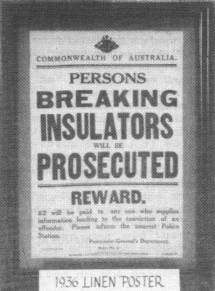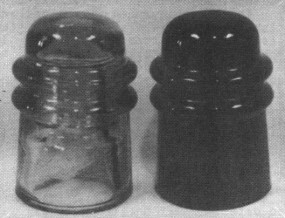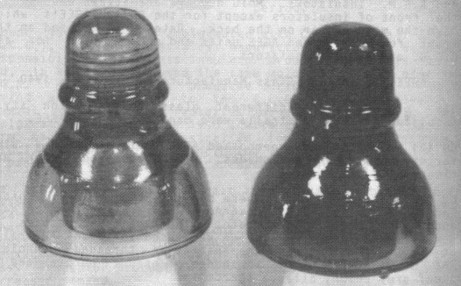From the Land "Down Under" - Australian Insulators
Reprinted from "Crown Jewels of the Wire", June 1986, page 22
Glass insulators were first manufactured in Australia in c. 1926 by
Australian Glass Manufacturers. Their factory was, and still is, located on
South Dowling Road in Sydney. Australian Glass Manufacturers (A.G.M.) had
developed a toughened type of glass very similar to Pyrex glass. Since the Pyrex
name could not be used due to trademark infringements, they called their glass
AGEE for Australian Glass. Many fruit jars, insulators, pie dishes and other
glass items were manufactured with this AGEE trademark during the 1926 to 1940
period.
 |
The linen warning poster is dated March, 1936, and reads:
"£ 2 will be paid to any one who supplies information leading to the
conviction of an offender. Please inform the nearest Police Station."
Postmaster - General's Department |
Around 1940, A.G.S. amalgamated with Crown Crystal Glass (C.C.G.), another
Sydney glass manufacturer. C.C.G. assumed responsibility for glass insulator
production at this time and, in some cases, used the same molds previously used
by A.G.M. All insulators produced during this 1940 - 1950 period are attributed
to the C.C.G. plant in Sydney. Several smaller glass factories joined this
A.G.M.-C.C.G. amalgamation during the 1940's with the resulting parent firm
becoming known as Australian Consolidated Industries (A.C.I.). Certain items,
including insulators, continued to be produced under the old tradenames,
however.
The A.G.M. division once again assumed responsibility for glass insulator
production in 1951, this time at their Hobart, Tasmania glass factory.
Insulators were manufactured at the Hobart plant from 1951 to 1964 and were
embossed A.G.M. Glass insulators never rivaled the manufacture or use of
porcelain ones in Australia though and glass insulator production ceased
completely in 1964 due to decreased demand.
Pinholes in Australian glass insulators are the standard one inch size with
the exception of the CD 490 (152.9) which is one and three-eighths inches.
Australian insulators have more threads per inch than their North American
counterparts, however, and cannot be used properly with North American pegs.
Glass insulators are rapidly becoming a thing of the past in Australia with
open-wire communication lines rarely existing near metropolitan areas. The
remaining open wire lines are being abandoned and dismantled everywhere with
very few insulators being saved as interest in them in Australia is quite
limited. In Hobart, Tasmania, barge-loads of insulators were pulled out into the
open Tasman Sea and dumped as the most expedient means of getting rid of them,
although most have been discarded by dumping and back-filling at sanitary land
fills. Australian glass insulators that have found their way to North America
will undoubtedly become more desirable items as it becomes more and more
difficult to acquire them, especially the rarer insulators.
Dating Australian Insulators
Some AGEE insulators and all C.C.G. and A.G.M. glass units are dated or have
coded dates. AGEE units are known to exist with (19)30, 33, 37 and 38 dates.
Some C.C.G. and A.G.M. units are dated directly, i.e. (19)42, 49, 59 and 61, but
most of these units have coded dates with double-dots (:) representing years.
Under this system, 4::: becomes 1943, 5::::: is 1955 and, to show a few of the
unusual ones, 61: is actually 1962, 58:: is 1960 and 4:::::::::: is 1950. The
extension of these dots was simply an expedient means of up-dating molds in use
without having to make new ones.
Mold numbers will also be embossed on CD 154, CD 422 (124.6) and CD 490
(152.9) Type II AGEE insulators and on all C.C.G. and A.G.M. insulators. Mold
numbers are always embossed on the front of insulators except for the CD 422
AGEE's which have the mold number on the back. Dates are embossed on the front
for all dated AGEE units and on the back for all C.C.G. and A.G.M. insulators.
AGEE (Australian Glass Manufacturers) c. 1926 - 1940
Six of the eight different glass communication style insulators made in
Australia were manufactured by AGEE.
CD 121 - Embossed and unembossed AGEE tolls exist in a wide variety of colors
and shades. The unembossed amber and clear tolls are rare.
CD 154 - These insulators were manufactured on special order for the South
Australian government and are reported to have been used only in that state.
They are exact copies of Hemingray-42 insulators which were used in South
Australia at that time (but with the Australian threaded pinhole). The CD 154
AGEE exists in shades of green, purple and a steel-grey color; all are scarce.
CD 420 (121.1) - Comes in light green only. Scarce.
CD 42l (Formally reported as 124.6) - S.C.A. color only. Scarce.

A clear and amber unembossed AGEE toll (CD 121).
CD 422 (124.6) - Comes in a wide variety of S.C.A.'s; greens, grey,
steel-blue, and straw colors. A deep emerald green color exists and is rare.
CD 490 (152.9) - Two distinct types of these large AGEE "bells"
exist. The earlier (author's conclusion) Type I bells have narrow domes, rounded
wire groove rims and flush inner skirts. A rare variety of this Type I bell
exists with four sharp drip points. Only three are known to exist in grey while
a small number exist in royal purple. Dates and mold numbers do not exist on any
of these Type I bells. Type II AGEE bells have wider domes, angular wire groove
rims and raised inner skirts. Colors for these AGEE bells range from light
S.C.A. to royal purple and greys for both types with a nice straw color (rare)
existing in the Type II bells only. Type I bells are more scarce then the Type
II bells. Neither is common.

TYPE I CD 490 "bells" embossed AGEE.
The one on the left is grey;
the right one is royal purple.
Note the four drip points on the base - 1 in each
quadrant.
C.C.G. (Crown Crystal Glass) 1940- 1950
Three styles of glass insulators were manufactured at the Sydney plant with
the C.C.G. embossing.
CD 422 (124.6) - Limited production of this AGEE style insulator continued
until 1942 - 43 with light straw and clear-smoke being the only two colors known.
CD 423 (124.7) - This was, without question, the most common and widely used
of all Australian glass insulators, manufactured from at least 1944 on. C.C.G.
embossed units exist in medium amber, light green and straw colors with the
medium amber and light green varieties being considerably more scarce than the
later, similarly colored A.G.M. 423s.
CD 430 (130.7) - Tall, narrow and, perhaps (author's opinion), the most
attractive of all Australian glass insulator styles. The range of pastel-like
colors in a set of CD 430's is a beauty to behold. C.C.G. 430's exist in at
least ten different colors or shades including medium and dark ambers, light and
medium S.C.A.s, bubbly clear, light green, peach, straw, etc.
A.G.M. (Australian Glass Manufacturers) 1951 - 1964
A.G.M. manufactured three styles of glass insulators at their Hobart,
Tasmania plant. They continued production of the popular CD 423 and CD 430
styles introduced by C.C.G. They also designed and manufactured the only glass
cable insulator ever produced in Australia; the short-lived CD 590 (250.7). Two
different sizes of embossed A.G.M. spools in clear glass also exist along with
one clear unembossed spool.
CD 423 (124.7) - Several shades of medium to dark amber exist along with
light greens and straws. Two insulators are known to exist in a bright yellow
color while another variety has been found with "SUB" embossed on the
rear below the coded date. This embossing indicated the insulator was designed
for use on sub lines instead of the major trunk lines.
CD 430 (130.7) - These A.G.M. insulators are more subtle in color than their
C.C.G. counterparts and exist only in light greens, peach and straws. Units
dated as late as 1962 exist in this CD; the latest date this author has observed
on Australian glass insulators.
CD 590 (250.7) - This low voltage, cable-top power insulator was introduced
in 1951 by A.G.M. but production was short-lived with all CD 590 units being
manufactured during 1951 only. These insulators carry the additional embossing
of "PI-3" on the front between the A.G.M. embossing and the mold
number. All CD 590 insulators are scarce with the amber and straw units being
more scarce than the various shades of light green.
HAPPY COLLECTING.
A BIG Thank You to Laura B. Van Der Endt of Randwich, New South Wales for
providing most of the historical data contained in this report.
| 